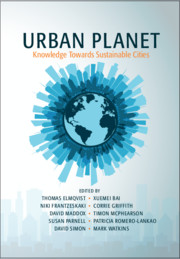We are moving to the era of digital towns and villages that are connected via the Internet for their commercial, financial, administrative, and social activities. Digital settlements will be the future of development; they are the trajectory of our urban planet.
With the urgent need for sustainable, inclusive, resilient and prosperous cities, as expressed in the Sustainable Development Goals and the Paris Agreement, and the New Urban Agenda cities must be reconsidered in terms of planning; housing; infrastructure development; economic development; environmental sustainability; social development; disaster exposure and resilience; and peace and security. The planning of twenty-first century cities must take into consideration the emergence of Information Communications Technology (ICT) infrastructure, social media, and the data revolution. This revolution is not only at the technical level but also reflects dynamic changes in modern life. More importantly, with the development of ICT infrastructure, workplaces are becoming more spatially mobile. The dichotomy between settlements, particularly between cities, towns, and villages, is becoming less relevant than it was traditionally perceived to be. Comparative advantages associated with urban settings, such as diffusion of ideas, innovation, economies of scale, and agglomeration, can also be achieved in connected sparse settlements. Today, settlements must be planned in consideration of these emerging parameters and conditions that point towards a new form of urbanization, one where digitally connected towns and villages offer social, economic, and political advantages traditionally only found in large, dense cities.
Over the past 15 years, national governments have created legal institutional frameworks to support regulatory mechanisms on the development and use of ICT. According to the World Bank (2016), between 2005 and 2015, the number of Internet users increased from 1 billion to 3.2 billion. Today, mobile phones are present in the majority of households (varying from 73 percent in sub-Saharan Africa to 98 percent in high-income countries), easing potential access to the Internet. By 2030, access to other ICT infrastructures will also be quasi-universal. Only 31 percent of the population in developing countries had access in 2014, compared with 80 percent in high-income countries (World Bank 2016). Making the Internet universally accessible and affordable should be a global priority.
The growth in ICT has given birth to e-commerce, e-banking, and so on – all of which have led to the creation of “digital villages” that will likely become the norm by the late twenty-first century, if not earlier. This will challenge all projections of urban population and size to 2050 and beyond. Although declines in the sizes of cities have been observed in past decades, the trend was mainly associated with suburbanization and the development of small- and medium-sized cities, it will be further pronounced with the emergence of new forms of digital human settlements, traditionally known as villages.
There are many examples of digitally served villages around the globe in which ICT advances have made spatial obstacles irrelevant and have opened up remote areas to the world with great local benefits. For example, the economy of the village Dongfeng in China’s Jiangsu province drastically changed in 2006 when a migrant from the village returned to open an online shop (World Bank 2016). His successful experience was expanded to other sectors; four years later, the village had six board-processing factories, two metal parts factories, 15 logistics companies, and seven computer stores serving 400 households engaged in online sales throughout China and in neighboring countries. In Uganda, wider mobile phone coverage is contributing to increased sale of perishable crops, such as bananas, from farmers in remote areas (Muto and Yamano Reference Muto and Yamano2009). In India, e-Choupal is easing access to the Internet, making it possible for farmers to place orders for inputs and to directly negotiate the sale of their produce with buyers (World Bank 2016). E-Choupal services reach over four million farmers growing a range of crops in over 35,000 villages through 6,500 kiosks across 10 states (www.itcportal.com/businesses/agri-business/e-choupal.aspx).
ICT makes it easier for people to buy and sell products beyond geographical boundaries, reduces the cost of transactions by a large margin, and opens remote areas to new opportunities. Yet, it also renders cities and villages that lack versatility irrelevant through ICT’s ability to shift to areas that can adapt and transform with its rapid evolution. Through ICT, villages have access to the latest innovations, can participate in democratic debates, and make their voices heard. Today, voices are not just originating from the cities but also from the villages. Finally, the emergence of these digitally served towns and villages will foster economic development without damaging the environment; there will be less consumption of land for private property and fewer cars, making streets friendly and healthy for walking and cycling. In the long term, this will reduce carbon emissions, promote the creation of low-carbon settlements, reduce land degradation, and promote biodiversity. These digitally connected settlements will provide economic advantages at a larger scale while safeguarding the environment. They will be sustainable, inclusive, and prosperous. This will mark the end of big cities and the rise of digital urbanization.



